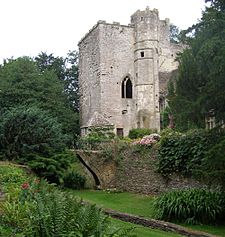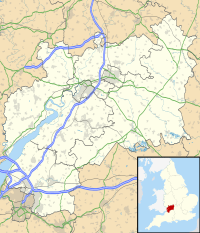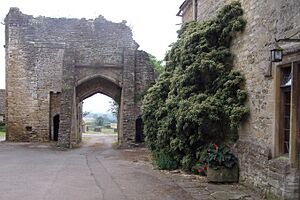Beverston Castle facts for kids
Quick facts for kids Beverston Castle |
|
|---|---|
| Gloucestershire, England | |

Beverston Castle south tower of western range
|
|
| Coordinates | 51°38′39″N 2°12′06″W / 51.644239°N 2.201553°W |
| Site information | |
| Owner | Private |
| Open to the public |
No |
| Condition | Inhabited |
| Site history | |
| Materials | Limestone |
| Events | English Civil War |
Beverston Castle, also known as Beverstone Castle or Tetbury Castle, is an old stone fortress in Beverston, Gloucestershire, England. It was built a long time ago, in the Middle Ages. Today, it's a mix of a manor house, smaller buildings, beautiful gardens, and the ruins of the old castle. Maurice de Gaunt started building this castle in 1229.
A lot of the castle has been in ruins since the 1600s. But some parts of the big 693-acre property are still lived in. This includes five cottages and a house from the 1600s with seven bedrooms.
Contents
What Beverston Castle Looks Like
The first castle was shaped like a pentagon, which has five sides. In the early 1300s, a smaller, square-shaped fort was added. A gatehouse with two towers was also built.
Beverston Castle is about three kilometers west of Tetbury. It is also about two kilometers east of Calcot Manor, which was once part of a medieval abbey. The castle is located in the Cotswolds, a beautiful area known for its natural beauty.
The Castle's Long History
People have lived in this area for a very long time. Signs of early Roman life have been found nearby. This suggests people were here as early as the 400s. Even older Iron Age people likely lived here too.
In the Middle Ages, the area was called Beverstane or Beverstone. Another old name was Bureston, because of the many blue stones found there.
Early Days and Important Battles
Around 1140 AD, a big battle happened near the castle site. It was fought between the English armies of King Stephen and Empress Matilda.
In 1225, Maurice de Gaunt started building a fortified manor house. He did this without official permission from the king. But on July 29, 1229, Henry III of England signed a document. This allowed the castle to stand and remain forever. Maurice de Gaunt was also known as Maurice de Ghent or de Gant. He was also called Maurice Paynel.
This early castle was protected by a T-shaped ditch. Part of this ditch is still there today as a moat on the south side.
Changes Over Time
In 1530, the castle was greatly changed by Thomas, Lord Berkeley. He built a small, square fort with a gatehouse that had two towers. A smaller square tower was added later, in the late 1400s. An adjoining house was built later, using parts of the original manor.
The wool industry was very important in the Cotswolds during medieval times. In 1336, a huge number of 5,000 Cotswold sheep were shorn in the castle courtyard. This might have been a record! The castle was updated again in 1348–1349. This was the second part of a big renovation that started in the 1330s.
Lady Frances and Sir John Berkeley lived here in 1555. Their daughter, Joanne Berkeley, was born here. Joanne later became an abbess, a leader of a convent in Brussels.
The English Civil War and Beyond
At the end of the 1500s, Sir Michael Hicks bought Beverston Castle. The castle stayed in the Hicks family until at least the early 1800s.
During the English Civil War in the mid-1600s, much of Beverston Castle was destroyed. Forces from Parliament attacked the castle twice. But the biggest damage came from an order to destroy its defenses. The two main attacks happened in 1644 and 1691. The western and southern parts of the castle, along with the gatehouse, still stand today.
A new house was built after a major fire in 1691. Since then, the property has been continuously lived in.
In 1842, the Hicks family sold Beverston Castle to R.S. Holford. Later, in 1939, the Hon Arthur and Mrs Strutt bought the property.
Castle Architecture
The large west part of Beverston Castle has square towers at its corners. It includes a solar, which was a private living room, above a vaulted undercroft (a stone-lined cellar).
The original 13th-century castle built by de Gaunt was pentagon-shaped. Two round towers from that time are still standing, though they are now ruins. The bluish limestone used for the castle seems to come from the same quarry as the stone for nearby Calcot Manor.
The two-story gatehouse was added by Lord Berkeley in the 1350s or 1360s. It still has one D-shaped tower. The gatehouse arch was fully intact in 2006. It would have been protected by a huge portcullis, a heavy gate that could be lowered. Above the archway was a large room on the first floor. The ruined northwest square tower dates back to the 1300s. It was changed again in the late 1400s.
The southern part of the castle, where people live today, was built by the Hicks family in the early 1600s. This shows that large manor houses were becoming safer at that time. This part of the castle was originally a medieval great hall.
Images for kids




